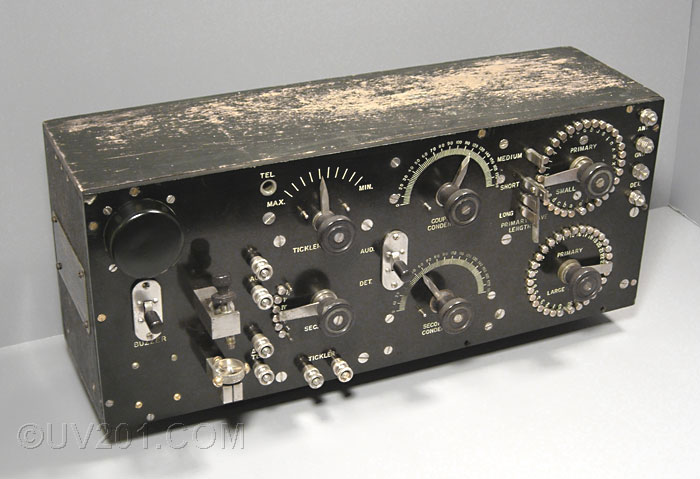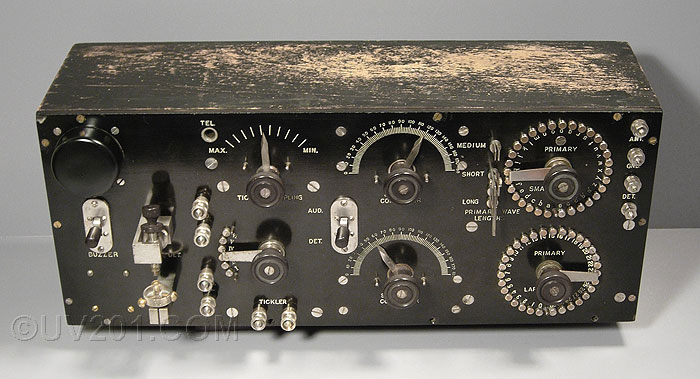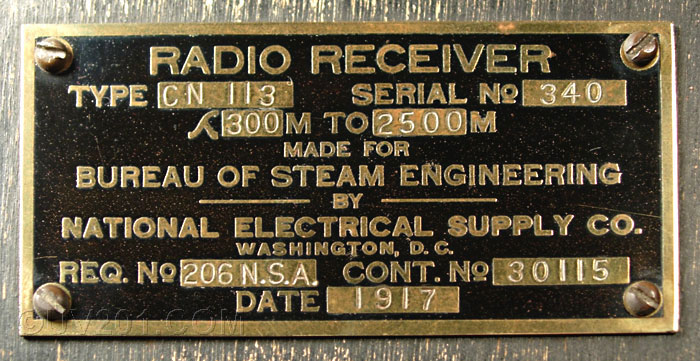|
1917 Navy Type CN-113 Receiver |
 |
| Featured here is the type
CN-113 receiver made by the National Electrical Supply Company (NESCO)
for the U.S. Navy in 1917. This unit covered a frequency range of about 33 kHz to 1 mHz, and it included a built-in crystal detector. Binding post connections were provided to allow it to be used with an external vacuum tube detector in a regenerative circuit or an alternate crystal detector. The switch in the center determined whether the crystal detector (the "DET" position) or the vacuum tube ("AUD" position) would be used. At the time, tubes were still generally called "Audions", the name given them by Lee DeForest, who invented the triode. In the upper left corner is a buzzer powered by internal batteries and controlled by the switch just below it. In operation, this buzzer produced an RF signal that was used to adjust the crystal detector for best sensitivity. In this example, the crystal and "cat's whisker" are missing, and the three screws which hold the crystal are not original. The name plate was originally mounted on the top of the case. Three versions of this receiver were produced. The CN-113A is identical to the CN-113, except the connections for the headset were made through binding posts rather than the standard 1/4 inch phone jack as seen on this unit. The CN-112 was smaller, and did not have the built-in buzzer and crystal detector. Otherwise, it was the same. There appear to have been other minor variations as well. Some examples that I have seen have had binding posts in the lower left corner rather than the four screws visible on this unit which would have allowed external buzzer batteries to be used. This would have simplified replacement which would require the removal of 14 screws. This is a very compact receiver, measuring about 17 inches wide, 7 inches high, and 6.5 inches deep. It weighs about 10 lbs. An installation of radio equipment on a WW-1 Sub Chaser can be seen in a very rare and interesting photograph featured on the Sub Chaser Archives web site. In this photo, a CN-113 or CN-113A (it's impossible to tell which) can be seen mounted on the wall just in front of the operator. |
 |
| The manual for this
receiver (.pdf format) can be seen
here. This
manual was created and issued by the Radio Test Shop of the Washington,
DC Navy Yard in June, 1918. It was approved and signed off by
William Eaton, whose name is associated with the
Eaton Oscillator seen
elsewhere on this site.
The last sheet in this manual lists the various contracts under which this receiver was manufactured. According to this information, 475 CN-113 and 600 CN-113A receivers were made. Only 15 CN-112 receivers were made, making it by far the rarest of the three versions. It may have been more of a prototype than a production design. |
 |